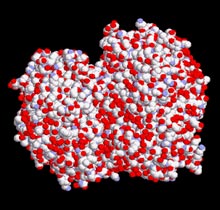Gold "Nanoplugs" Wire Up Enzymes

Atomic model of a glucose oxidase enzyme molecule. This enzyme oxidizes glucose and produces electrons that can be channeled into an electrode through a gold nanoparticle connection. This system can be used to better detect glucose for diabetic patients. The technique might also be applied in the rapid and inexpensive detection of pollutants, infections, disease markers, or agents of bioterrorism
Could yield biosensors with greater sensitivity, specificity
Scientists at Hebrew University, Israel, in collaboration with researchers at the U.S. Department of Energy’s Brookhaven National Laboratory, have devised a way to use gold nanoparticles as tiny electrical wires to plug enzymes into electrodes. The gold “nanoplugs” help align the molecules for optimal binding and provide a conductive pathway for the flow of electrons. The research, described in the March 21, 2003, issue of Science, may yield more sensitive, inexpensive, noninvasive detectors for measuring biological molecules, including, potentially, agents of bioterrorism.
The idea behind the technology, says Brookhaven biologist Jim Hainfeld, who developed the gold nanoparticles and the means of attaching them to other molecules, is to measure the current as an indicator of the number of biological molecules involved in the reaction.
Atomic model of a glucose oxidase enzyme molecule. This enzyme oxidizes glucose and produces electrons that can be channeled into an electrode through a gold nanoparticle connection. This system can be used to better detect glucose for diabetic patients. The technique might also be applied in the rapid and inexpensive detection of pollutants, infections, disease markers, or agents of bioterrorism.
One potential application, developed by the Hebrew University collaborators, is to use sensors made from the enzyme-electrode system to measure blood glucose in diabetic patients. In the Science paper, the authors describe how they used gold nanoparticles to attach a glucose-oxidizing enzyme to an electrode, and then used this bioelectrocatalytic system to measure glucose levels.
“The gold nanoparticle —1.4 nanometers, or billionths of a meter, in diameter — plays two very important roles,” says Hainfeld. “First, it specifically orients the binding of the enzyme to the electrode so it’s a very ordered attachment, not random. Second, since gold is a conductor, it provides an electrical path for the flow of electrons.”
When the enzyme oxidizes glucose, electrons flow through the gold nanoparticle into the electrode: The higher the current, the higher the level of glucose.
The experimental results indicate that current flowed seven times faster with the “plugged-in” enzyme system than with the normal enzyme using oxygen as an electron acceptor. Previous attempts to wire the enzyme to an electrode have resulted in lower than normal rates. Higher flow rates increase the ability of sensors made from such a system to detect lower quantities of glucose.
Another important finding was that the measurement of glucose using the plugged-in enzyme-nanoparticle system was not affected by the levels of other substances that can interfere with accurate glucose readings, such as oxygen and ascorbic acid, which is frequently a problem with other biosensors.
Three molecules of glucose oxidase, two wired with gold nanoparticles (yellow, indicated by arrows), visualized with the scanning transmission electron microscope (STEM) in Brookhaven Lab’s biology department.
This increased sensitivity and specificity could improve the next generation of glucose-monitoring sensors, particularly those that measure glucose without piercing the skin, which rely on detecting trace quantities.
The plugged-in enzyme technique is not limited to glucose detection. “Many other substances could be attached to electrodes in this way and used to sensitively and easily detect other biological molecules, such as bioterrorism agents or other disease markers,” Hainfeld said.
And because such sensors would be intrinsically simple, containing just a few molecules and an electrode, they would be very compact, inexpensive, and disposable.
The Brookhaven researchers were primarily involved in developing the methods for producing and attaching gold nanoparticles to other molecules, and confirming their presence in the glucose-oxidizing enzyme complex using Brookhaven’s scanning transmission electron microscope. The researchers at Hebrew University used these tools to make the improved biosensors by labeling the enzyme, wiring it to electrodes, and measuring its activity. Brookhaven’s role in the work was funded by the National Institutes of Health and the U.S. Department of Energy, which supports basic research in a variety of scientific fields.
Media Contact
More Information:
http://www.bnl.gov/bnlweb/pubaf/pr/2003/bnlpr032003.htmAll latest news from the category: Life Sciences and Chemistry
Articles and reports from the Life Sciences and chemistry area deal with applied and basic research into modern biology, chemistry and human medicine.
Valuable information can be found on a range of life sciences fields including bacteriology, biochemistry, bionics, bioinformatics, biophysics, biotechnology, genetics, geobotany, human biology, marine biology, microbiology, molecular biology, cellular biology, zoology, bioinorganic chemistry, microchemistry and environmental chemistry.
Newest articles

Compact LCOS Microdisplay with Fast CMOS Backplane
…for High-Speed Light Modulation. Researchers from the Fraunhofer Institute for Photonic Microsystems IPMS, in collaboration with HOLOEYE Photonics AG, have developed a compact LCOS microdisplay with high refresh rates that…

New perspectives for material detection
CRC MARIE enters third funding period: A major success for terahertz research: Scientists at the University of Duisburg-Essen and the Ruhr University Bochum have been researching mobile material detection since…

CD Laboratory at TU Graz Researches New Semiconductor Materials
Using energy- and resource-saving methods, a research team at the Institute of Inorganic Chemistry at TU Graz aims to produce high-quality doped silicon layers for the electronics and solar industries….



